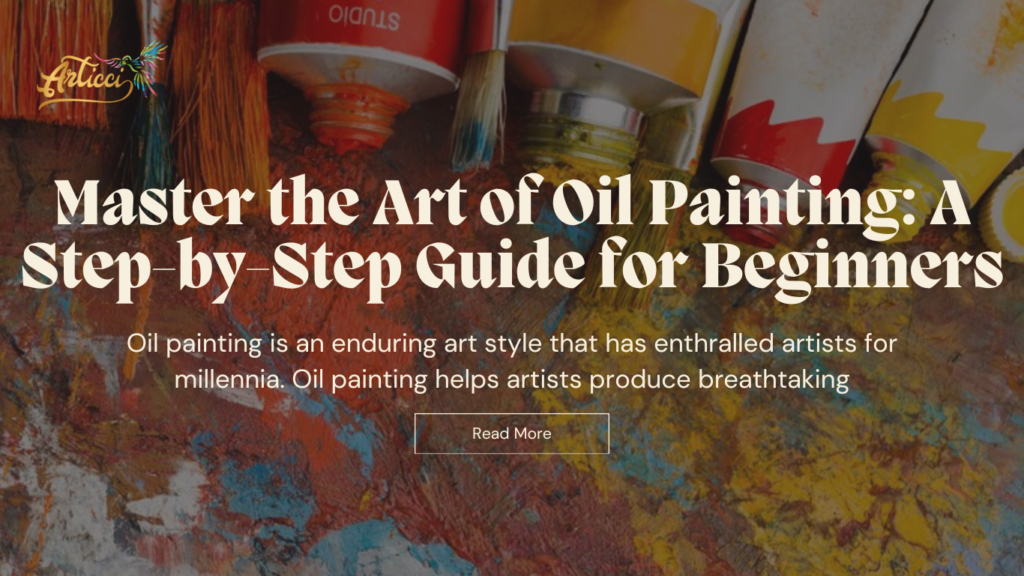No products in the cart.
Manu Verma
04/27/2024
Oil painting is an enduring art style that has enthralled artists for millennia. Oil painting helps artists produce breathtaking masterpieces because of its rich colors, silky textures, and ability to merge smoothly. This step-by-step book will help you master the art of oil painting, whether you’re a novice or an established artist wishing to enhance your talents.

To begin oil painting, it’s crucial to understand the various types of oil paints and supplies required. Oil paints consist of pigments mixed with drying oil like linseed or walnut oil, with a slow drying time allowing artists to work for extended periods and smoothly blend colors.
Investing in high-quality supplies is crucial for successful painting. You need a palette, brushes, and canvases or boards. Articci: The Best Art Supplies Shop in Australia offers a wide range of oil paints and supplies to ensure you have everything you need to create your masterpiece.
Choosing the right brushes and canvases is crucial for oil painting. For beginners, round brushes in various sizes are a great starting point, as they are versatile for detailed work and broader strokes.
When it comes to canvases, there are two main options: stretched canvases and canvas boards. Stretched canvases are ready to paint on and provide a sturdy surface for your artwork. Canvas boards, on the other hand, are lightweight and portable, making them ideal for plein-air painting. Consider the size and surface texture of the canvas when choosing, as these factors can greatly impact your painting experience.
To effectively paint oil, create a dedicated workspace with ample natural light and well-ventilated conditions. This will allow you to see the true colors of your paint and prevent accidental spills or stains.
Maintain a clutter-free workspace by organizing your supplies in an easily accessible manner, allowing you to concentrate on your painting without any distractions. Additionally, make sure to have a clean rag or paper towel nearby for wiping brushes and palette knives.
Now that you have your supplies and workspace ready, it’s time to learn some basic techniques for oil painting. One of the fundamental techniques in oil painting is the concept of “fat over lean.” Each paint layer should have more oil than the previous one to ensure proper drying and prevent cracking over time.
Another important technique is color mixing. To achieve desired shades and tones, experiment with various color combinations, starting with a small amount of paint and gradually adding more as needed to avoid wasting paint and improve color palette control.
The guide offers a step-by-step guide on creating your first oil painting, starting with lightly sketching the subject on the canvas using pencil or charcoal.
Next, begin blocking in the main shapes and colors using a large brush. Don’t worry about details at this stage; focus on capturing the overall composition and color scheme of your subject. Once you’re satisfied with the initial blocking, start adding more details and refining the shapes using smaller brushes.
Continue building up layers of paint, allowing each layer to dry before adding the next. To enhance the depth and dimension of your painting, it’s crucial to regularly evaluate your progress from a distance and make any necessary adjustments.
The text provides tips and tricks for improving and refining oil painting skills.
Oil painting offers a wide range of styles and techniques to explore. From realistic landscapes to abstract expressionism, there’s something for every artist’s taste. Experiment with different brushwork, color palettes, and subject matter to find your unique style.
To pick up new skills and get ideas from other artists, think about enrolling in seminars or workshops. You will develop as an artist the more you experiment and push the limits of oil painting.
Articci: The Best Art Supplies Shop in Australia is your go-to place for high-quality art supplies for your oil painting adventure. Articci has a large collection of oil paints, brushes, canvases, and other supplies to help you express your creativity. Browse their huge inventory online or in-store to locate the appropriate supplies for your next masterpiece.
Oil painting is a creative art technique that can be mastered through learning its fundamentals, practicing various techniques, and developing a unique style by capturing the environment around you. So grab your brushes, pay a visit to Articci: The Best Art Supplies Shop in Australia for all of your painting supplies, and let your creativity run wild on the canvas. The options are limitless!
Manu Verma
04/27/2024
Manu Verma
04/23/2024
Manu Verma
04/14/2024
Manu Verma
04/09/2024